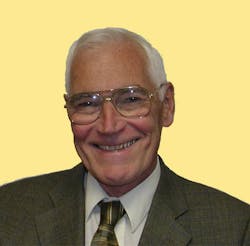On April 29 Prof. H. Angus Macleod passed away at the age of 87. He was a unique expert in optical coatings. His work had a substantial influence on optics and photonics as we know it. And he had a good sense of humor. In August 1997 he was cited in Laser Focus World: “It´s a small wonder that so many thin filmers have white hair!” Helping people to avoid getting white-haired with coating problems was what he did.
Angus was born and educated in Scotland, he studied natural philosophy at the University of Glasgow. In 1956 he started at Sperry Gyroscope Company as Research Engineer, he “... discovered that most of the other people didn’t really understand rigid-body dynamics, and so I got all the problems that involved nutation and vibration and things like that” as he told Donald Mattox in an interview in 2002.
In 1962 he joined Williamson Manufacturing Co. as Chief Development Engineer. “… and they were also getting into the photography business. So, that was a bit of optics. Up until then, I hadn’t really done much optics. I suddenly found myself designing optical systems, and came across something called an interference filter, and a book ‘The Optical Properties of Thin Solid Films‘, written by Oliver Heavens, Prof. of Physics, University of York”. He never expected that it would be he to write a book on that topic, which for more than 50 years now many have referred to as the bible of coating design.
Before writing the book, he had the chance to learn from the author of the older one: In 1962, when he worked as manufacturing physicists at Mervyn Instruments Ltd., he started to work on the topic that should cover six decades of his life: “I legged it down the road [to Royal Holloway College], saw Ollie Heavens, formed a relationship with him, which has continued ever since, and learned quite a bit from him, drew up some plans for this 12-inch infrared coating machine, and we actually made some multiple-cavity filters for the nitrous oxide line in the infrared.”
It was 1969 when his own book Thin-film Optical Filters was first published. At that time, he led the thin film division at Parsons & Company in Newcastle Upon Tyne. He soon started a scientific career as a Reader in Thin Film Physics in Newcastle Upon Tyne Polytechnic. It could have been a quiet life.
But then he took a phone for a call from America: "I’m Peter Franken and I’m the Director of Optical Sciences Center at the University of Arizona. If we were to offer you a Professorship in Optical Sciences, would you consider it?” Angus did not think twice: “I said, ‘Yes, I’d consider it.’ I mean, a question like that to a Scotsman, a Scotsman will consider anything. ‘We have this university at the South Pole. Would you consider it?’ ‘Of course, I’d consider it.”
At the University of Arizona Angus was Professor for Optical Sciences from 1979 to 1995. Beside educating generations of physicists, he worked in numerous fields: coatings for telecom, deposition and microstructure, color, monitoring, theory and standardization, to name but a few.
In 1986, Angus co-founded Thin Film Center, Inc. which provides software for optical thin film design, analysis, and fabrication. When he retired from academia in 1995, he did so to devote more time to his company.
But he never stopped sharing his knowledge. He travelled a lot and his courses on "Optical Thin Films" became famous around the world. He inspired many people who valued him for so much more than just being a brilliant physicist. He was a gifted piano player and he possessed very broad general knowledge.
Germany, and particularly Jena, was a frequent destination for him. In the nearby town of Weimar, he visited the house of the famous German poet Johann Wolfgang von Goethe. At this occasion, Angus explained to his colleague and friend Norbert Kaiser from Fraunhofer IOF what Goethe wrote in a letter to fellow philosopher Jacobi: “Light is the simplest undivided, most homogeneous being that we know. Opposite him is the darkness.” It seems obvious that such broad general knowledge and a borderless attitude of thinking were essential in Angus’ talent to understand thin optical films and to teach this knowledge to several generations of experts.
Angus wrote in his preface to the Fourth Edition of his book: “The field of optical thin films has been very good to me. I cannot imagine a more friendly, supportive, and open group of people than the international optical thin-film community. It sets an example the rest of the world would do well to follow.”
This obituary would not have been possible without the generous support of Angus' old friend Norbert Kaiser. Norbert helped me with all the photos, stories and quotes, for which I would like to thank him very much.

Andreas Thoss | Contributing Editor, Germany
Andreas Thoss is the Managing Director of THOSS Media (Berlin) and has many years of experience in photonics-related research, publishing, marketing, and public relations. He worked with John Wiley & Sons until 2010, when he founded THOSS Media. In 2012, he founded the scientific journal Advanced Optical Technologies. His university research focused on ultrashort and ultra-intense laser pulses, and he holds several patents.


